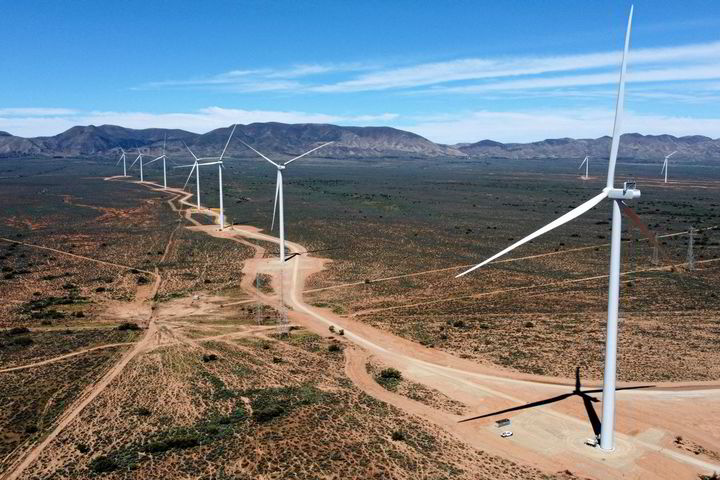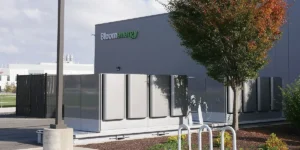OPINION | Can high power prices on the world’s most renewables-reliant grid be reduced by green hydrogen?

The state of South Australia has been a pioneer in wind and solar, increasing its renewable share of generation from 1% to a world-leading 70% in just over 20 years.
As the former premier Jay Wetherill once said: “South Australia is an unusual place in a way it’s really a slither of a population perched on the edge of a desert and climate change represents particular risks to us. This isn’t an academic exercise for us.”
But while it has been successful in going green, consumers have been seeing red with the state consistently seeing increases in wholesale electricity spot prices — especially when the wind isn’t blowing and the sun isn’t shining.
One question is increasingly being asked: Can green hydrogen produced using negatively priced excess renewable energy be stored and used to generate electricity at times when wholesale prices are high, thus reducing the overall cost of power?

Many have blamed high prices on a lack of competition with generation concentrated among a few big players; some have blamed the lack of baseload when South Australia closed its last coal power plant; and others the lack of dispatchability with weather-dependent wind and solar.
I am convinced, however, that the problem is how the market works.
Article continues below the advert
Generators submit bids to the network operator, normally based on their marginal cost. Solar and wind with low operating costs bid low and are selected first. The next cheapest is selected, which then forms a bid stack until all demand is satisfied. But the price the generator receives is not what each bidder bid. It’s the last bid.
Burning natural gas in on-demand peaker plants is a perfect energy source for quickly filling in the gaps left by a lack of wind or sunshine — but it’s expensive.
And when it wins the last bid, all the other participants receive the same price. So while wind and solar may be cheap on a levelised cost basis — around A$50-60 (US$32-39) per MWh — they get paid for those select hours as if they are an expensive peaker plant — which can be A$300/MWh or more.
But it’s not just gas that is the problem. South Australia is connected to other states’ electricity supplies, which can also help to fill the renewable energy gaps.
The South Australian Productivity Commission looked at the interdependence of the interconnectors and found that when the state exports excess renewable energy, this attracts a low price. When it needs to import electricity, this is at a premium. And if the line is down, you’re back to expensive gas peakers and diesel gensets.
And this brings up another problem when inter-connectors are down. If supply cannot meet demand, then the price will continue to rise until it reaches the market cap of A$16,000/MWh. And if solar and wind are bidding at this time, they also receive this price.
Electricity retailers trying to financially engineer their way out of high prices also get effected. Using swap contracts and caps, they are able to hedge against volatility, but at a cost. The Productivity Commission found retailers ended up paying for the upcoming year at about 1.1 times the prior year’s spot price. So smoothing out the current year comes at the cost of the upcoming.
Can the market deliver cheap green hydrogen by absorbing excess electricity?
In late 2022, the government issued a request for proposal (RFP) to build a 250MW electrolyser and a 200MW 100% hydrogen power plant. According to the government’s Hydrogen Jobs Plan, A$593m has been allocated to the project.
This includes A$220m for the electrolyser, A$31m for 3,600 tonnes of liquified hydrogen storage and A$342m for the power plant. A tight deadline of 2025 has been set so that South Australia can attain a first-mover advantage.
But this RFP was unusual in that the electrolyser would only run 22% of the time, and the peaking plant 7% of the time. Normally electrolysers are connected to the grid and run as much as possible to maximise output and therefore reduce the levelised cost of hydrogen.
So why only run the electrolysers occasionally?
Due to its high penetration of renewables, the state has large price swings. In 2023, 7% of hourly generation had an average spot price of $480/MWh. But also, for 22% of the time, the spot price averaged minus $30/MWh as too much renewable energy flooded the grid.
The South Australia government therefore thought it could use excess electricity to produce green H2 when the power price is negative, and use it to produce electricity when prices peak.
Simple right? Well, it is until you start looking more deeply into the numbers.
At $220m for the electrolyser and using negatively priced electricity, the levelised cost of hydrogen would come in at around A$1.50/kg — less than the holy grail of US$1/kg at today’s prices.
But even at this low price, I calculate that the peaker plant would produce electricity at A$400/MWh. Still expensive due to the low capacity factor but technically slightly cheaper than recent spot prices.
On top of this, first-mover advantage also entails first-mover risks.
PEM electrolysers — which are more flexible and suitable for intermittent loads — are still expensive and cost about A$3,000/kW (according to Australia’s chief scientific body, the CSIRO), or A$750m for the project.
This is over three times what the South Australian government has set aside, and brings into question their optimism.
Use these more realistic figures and the green hydrogen would cost $8/kg just for the capex and financing. Offset this with negative electricity prices of minus $1.50/kg, add a bit of operating costs and the total cost of the H2 is looking closer to A$7/kg than A$1.50/kg.
| Electrolyser comparison | Size (MW ) |
Capital cost (A$) | Cost per kW (A$) | Capex (A$/kg) | Power feedstock (A$) | Electricity (A$/kg) | O&M (A$) | Total (A$) |
| Electrolyser cost (SA govt) | 250 | 220m | 880 | 2.40 | -30 | -1.50 | 0.60 | 1.50 |
| Electrolyser cost (CSIRO estimate) | 250 | 751.5m | 3,006 | 8.00 | -30 | -1.50 | 0.60 | 7.10 |
Notes: Electrolyser consumption 50 kWh/kg, capacity factor 22%, peaker plant capacity factor 7%. WACC 7.7%, O&M as per Aurecon estimates
At 7.4kg of hydrogen for a gigajoule (GJ) of energy, this works out to be close to A$50/GJ (A$180/MWh) and by the time you lose two thirds through the peaker plant’s turbine as wasted heat, it’s close to $600/MWh just for the feedstock.
And that’s before you take into account the likely costs of creating the hydrogen peaker plant.
Peaker plant costs
The 200MW green hydrogen peaker plant for South Australia would likely be a world first — there are no large-scale facilities of this kind anywhere on Planet Earth today. And none are forecast to be built before 2030.
Aurecon, an Australian engineering firm that prepares many of the Australian Energy Market Operator’s (AEMO) estimates, has a hypothetical cost of a large scale hydrogen peaker at $860/kW.
The firm has stated that small-scale 100% green hydrogen peaker plants do exist, but these cost $2,150/kW. With an aggressive timeline to complete South Australia’s H2 peaker by the end of 2025, developers may decide that they would have to build many small units.
The government proposal anticipates it running 7% of the time. This doesn’t leave many electrons to allocate the high cost to. Including the capital cost, hydrogen feedstock with a bit of operations and maintenance costs, the final electricity price using many units of small-scale peakers would be close to $960/MWh.
| Power plant comparison | Size (MW ) |
Capital cost (A$) | Cost per kW (A$) | Capex (A$/MWh) | H2 feedstock (A$/kg) | Electricity (A$/MWh) | O&M (A$/MWh) | Total (A$/MWh) |
| H2 Peaker Plant (SA Govt) | 200 | 342m | 1,710 | 263 | 1.50 | 133.20 | 10.00 | 396.20 |
| H2 Peaker Plant (Aurecon) | 200 | 430m | 2,150 | 330 | 7.10 | 630.48 | 10.00 | 960.48 |
Notes: Peaker plant capacity factor 7%. WACC 7.7%, O&M as per Aurecon estimates
Very expensive?
The government goal is to bring down electricity prices by minimising price spikes. But power companies recoup the cost of their investments through price spikes.
Balancing this will be tricky. Look to recoup the cost of an expensive hydrogen peaker plant and you need high spot prices. Bid below cost to become the price setter, you can pull down spot prices but you may find demand increases and you need more hydrogen supply to meet demand. Don’t have enough hydrogen supply and you’re back to relying on expensive gas.
So can South Australia use green hydrogen to reduce its high cost of power?
The numbers show that it is unlikely by the stated deadline of 2025, but one day it may be — especially if wholesale electricity prices continue to rise.
John Poljak is the founder of keynumbers.com, an Australian website dedicated to analysing energy and economic issues




